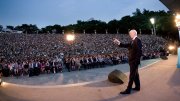In 2018, when Osman Khalid Waheed ’93 and Qudsia Rahim were organizing the inaugural Lahore Biennale, a large-scale international contemporary art exhibition, they ran into a problem: there were no contemporary art museums in the Pakistani city to display the artwork. “That could have been seen as a hindrance, something that was holding [the project] back,” says John Tain ’96, curator of the third edition of the biennale, which opened October 6 and will run until November 8. “Instead, they turned that into a strength: if there is no art museum, we have to take our art to the people.” They decided to install artworks in public spaces throughout the city, such as the Sheesh Mahal, a seventeenth-century Mughal palace.
This year’s biennale continues to break boundaries—between art and non-art, borders, and time periods. Titled “Of Mountains and Seas,” it engages with the climate crisis, ecologies, and sustainability, and features more than sixty artists from over thirty countries. “We think of the climate crisis as an Anthropocene problem,” Tain says, “something that has stemmed from the last 50 or 100 years. But [South Asia] is a region that has dealt with extremes of weather, temperature, and humidity for all of its recorded history.” There is a long artistic heritage of responding to those extremes, such as the Summer Palace—the name for the basement of the Sheesh Mahal, which features a passive ventilation system that keeps the space cool even as temperatures soar above 120 degrees Fahrenheit. This year’s biennale seeks to use such spaces as the backdrop for contemporary artworks that address climate change around the world.
One artwork by contemporary Filipino artist Leeroy New, for instance, is installed in the Shalimar Gardens, a 500-year-old Mughal garden complex in Lahore. New’s piece depicts a goddess of death and fertility from the tradition of the Bagobo—an indigenous people of the Philippines—as an alien in a spaceship. Constructed of bamboo and recycled water bottles, the piece is “a way of understanding the life cycles of objects and commodities that make up consumer culture,” Tain says. The juxtaposition between the modern artwork and the historic setting encourages viewers to draw connections between past and present, the Philippines and Pakistan.
The desire to facilitate such connections has driven the Lahore Biennale Foundation since its inception, says Waheed, one of its founders. The idea originated in 2014, when the Pakistani ambassador to Argentina sought to host an exhibition of Pakistani art in Buenos Aires to introduce the country’s artistic heritage to an Argentine audience. The ambassador asked Qudsia Rahim, then a professor at the National College of Arts in Lahore, to curate—and reached out to Waheed’s pharmaceutical company for funding. After that initial project, Waheed and Rahim stayed in contact, exploring art’s potential as a means of societal healing. “If you look at Pakistan’s recent history—particularly the last four of five decades—it’s seen so much violence,” Waheed says. One way to “respond to that trauma, and to try to build a more humane society, is through the arts.” The pair founded the Lahore Biennale Foundation in 2014; the following year, they organized a collateral event at the Venice Biennale titled “My East is Your West,” which featured art “questioning the notion of borders and boundaries,” Waheed says.

One artwork in this year’s show deals with more recent climate adaptations. Because water is delivered only at certain times of day in Lahore, many residents rely on backup, rooftop water tanks. For the biennale, the Pakistani artist Imran Qureshi painted some of those blue tanks with orange splatters and floral patterns. He then photographed the tanks, zooming in to emphasize the intricate patterns. Qureshi used these photographs to create two public art installations: a tile frieze in an underground pedestrian pathway; and a window installation at Shalimar Gardens Station. He also placed some of the painted tanks on a rooftop visible from the station platform. The water tanks “are a part of everyday life that people just ignore and don’t see,” Tain says. With this artwork, viewers are encouraged to engage with their environment, to “see and notice what it is that enables their everyday [lives].”
From November 2 to 8, the biennale will host a Climate Congress, accessible to attendees both in-person and remotely, during which researchers will discuss art’s role in addressing climate change and facilitating cross-border collaboration. “China thinks of itself as China, and India as India, and Pakistan as Pakistan. But the climate crisis doesn’t care about any of those borders,” Tain says. “The only way people will be able to adapt successfully is if they are not limited by these borders and think of ways to work around them.”









